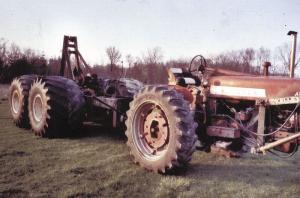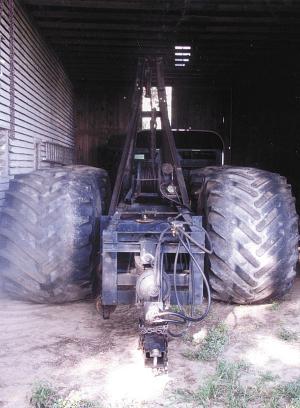2010 - Volume #34, Issue #1, Page #42
[ Sample Stories From This Issue | List of All Stories In This Issue | Print this story
| Read this issue]
"Winches On Wheels" Pull Out Stuck Tractors, Sprayers
 |
 |
The father and son team recently sent FARM SHOW photos of two heavy duty "winches" they built to pull behind their Farmall 450 tractor. They're built almost entirely from junkyard material.
"We use the rigs to help out our neighbors," says Deane. "Many times they've already tried to pull out a tractor, self-propelled sprayer, or combine but couldn't, and we're their last resort. We don't charge them anything because it makes us feel good that we can help. Our toughest job of all was the time we pulled out a 52,000-lb. Poclain excavator buried 6 ft. deep in the ground."
One winch is built on a tri-axle semi trailer frame that measures 21 ft. long. The Sarbers cut off about one third of the trailer frame and added a hitch. The rig is equipped with an old gravel mining winch (old-timers called it a high-line) that measures 4 ft. wide and is equipped with 7/8-in. dia. cable that rides on a 3-in. dia. shaft. The cable rides up and over a snatch block that's mounted on a steel frame 4 ft. off the trailer floor, and then over a steel "anchor" on back of the trailer. The anchor is lowered to the ground to stabilize the rig as it pulls.
The winch is hooked up to two transmissions and three gearcases that are chain-driven off the tractor's pto. The transmissions are off an old Ford Model A car and are used together as a gear reverser and also to control the winch's speed. The transmissions are backed up to each other, with one set in a forward gear and the other in reverse. A gearshift lever extends up from each transmission and is used to control speed and direction. The three gearcases further reduce the winch's speed.
"We needed a gear reverser because the tractor pto can't be reversed," says Deane. "They make gearcase reversers for wreckers that are controlled by moving a lever back and forth, but we couldn't find one."
The big tri-axle winch works great on solid ground but weighs about 20,000 lbs., so it can't get close to a stuck machine if the ground is very muddy. So the two men came up with a second winch that rides on four big 67 by 43 by 25 flotation tires off a Big A self-propelled sprayer.
The self-propelled, 4-WD tandem axle unit is built on a twin-screw International semi tractor. A Farmall tractor's hydraulics are used to operate a pair of hydraulic motors. One motor chain-drives the winch and the other motor chain and shaft-drives the wheels. The winch is designed to lift the machine straight up and then pull it out. "This winch works especially well on self-propelled sprayers, which have a hitch that's about 6 ft. off the ground. You need lifting power to pull the machine up before you can pull it out," says Deane.
To make room for the big flotation tires, the Sarbers had to cut off the driveshaft between the semi tractor's two rear ends, then move the front rear end forward and also lengthen the driveshaft. They also bolted two gearcases onto the driveshaft to reduce its speed.
And they beefed up the driveshaft. "We welded a 4-in. dia., thick-walled pipe onto the original driveshaft and onto the rear end's U-joints. It has no trouble driving the rear ends no matter how big the machine is that we're pulling out," says Deane.
"At first we tried using the tractor's pto to drive a truck transmission, but the transmission couldn't handle the torque. The sides of the gearcase split out, and the driveshaft got bent so bad it almost looked like a pretzel. So we switched to hydraulics."
To go on the road they first pull a pin to unhook the driveshaft from the front rear end. Once they get to the field they hook up the driveshaft to the gearcase to lock the wheels.
Contact: FARM SHOW Followup, Deane Sarber, 18568 6th Road, Plymouth, Ind. 46563 (ph 574 936-8551; djsarber@kconline.com).

Click here to download page story appeared in.

Click here to read entire issue
To read the rest of this story, download this issue below or click here to register with your account number.




